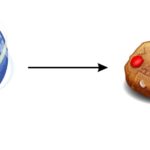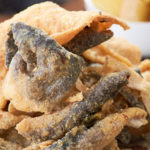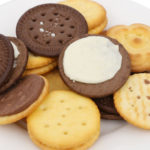If you’re a fan of biscuits and cookies, but have always struggled to differentiate between the two, then read on as we explore the key distinctions between these tasty treats.
1 What is a Biscuit?
A biscuit is a baked or cooked good, typically flat, crisp, and sweet in flavor. They are often made with flour, sugar, and some form of shortening or fat (such as butter or oil). Additional ingredients such as nuts, raisins, chocolate chips, or other flavorings can be added to enhance the taste.
 Biscuits
Biscuits
In English-speaking countries, except for the US and Canada, crisp cookies are referred to as biscuits. In Vietnam, biscuits are often called “bánh bích quy”.
Reference: 3 beautiful and simple ways to make Christmas cookies
2 What is a Cookie?
In Vietnamese, cookies are also known as bánh quy, and they are baked at an ideal temperature to achieve a crisp and crunchy texture. They are typically rounder and thicker than biscuits, with a rich and buttery flavor.
Cookies also share similar primary ingredients to biscuits, such as flour and sugar, but with additional ingredients like dried grapes, oatmeal, chocolate, and various types of nuts.
 Cookies
Cookies
3 How are Biscuits and Cookies Different?
Origin
Biscuits first originated in the 7th century BC in Persia (present-day Iran). However, it was only after the Spanish invasion of Morocco that this type of baked good became popular in Europe.
The biscuits we know today, however, originated in France. In the 14th century, they were sold on the streets of Paris, and from there, various recipes for biscuits emerged and spread worldwide.
 Origin of Biscuits and Cookies
Origin of Biscuits and Cookies
On the other hand, cookies have their roots in the Netherlands, with the name “Koekje”, describing the small, round shape of the baked good. It also signifies a carefully baked small, round cake. However, it was Ruth Graves Wakefield, the owner of the Toll House in the US, who created and sold these treats, making them famous.
Unlike the Dutch cookies, the American version added chocolate chips to enhance the flavor. This variation of the cookie became far more popular than its traditional counterpart.
Texture and Baking Technique
When examining the names of these two treats, we can already see some distinct differences in their shapes and baking methods.
The word “biscuit” comes from the Latin “bis” (twice) and “coquere” (to cook), indicating that the dough is cooked twice. In terms of texture, biscuits are crispier, harder, thinner, and have a flatter surface than cookies. They are made with simple ingredients like butter, flour, and sugar, but the dough needs to be thicker than cookie dough to achieve the right consistency.
 Differences in Texture and Baking Technique
Differences in Texture and Baking Technique
On the other hand, the term “cookie” originates from the Dutch word “koekje”, which means “small cake” or “cake baked twice”. This type of baked good is softer, thicker, and has a more rugged exterior compared to biscuits.
Ingredients
Compared to cookies, biscuits have a simpler composition, typically made with just three main ingredients: flour, butter, and sugar.
In some places, people have made biscuits even more interesting by dipping them in various chocolates or drizzling them with chocolate or caramel. Additionally, biscuits can be coated with a layer of cream or sandwiched together with a creamy filling.
 Ingredients of Biscuits and Cookies
Ingredients of Biscuits and Cookies
Cookies, on the other hand, are distinguished by the additional ingredients that are mixed directly into the dough before baking, such as chocolate chips, various nuts, dried grapes, caramel, and cookie crumbs. These add-ins are not just for decoration but are integral to the flavor and texture of the cookie.
4 Popular Types of Cookies
Brownie Cookies
Brownie cookies originate from England and get their name from the brown color derived from chocolate or cocoa. They have a soft and fluffy texture, a rich and buttery taste, and a hint of bitterness from the chocolate or cocoa. They are best enjoyed with a side of cold cream to balance out the richness.
 Brownie Cookies
Brownie Cookies
Chocolate Chip Cookies
Chocolate chip cookies are considered quite similar to traditional cookies, but with the addition of chocolate chips, a buttery flavor, and a small, round shape, making them perfect for tea parties.
 Chocolate Chip Cookies
Chocolate Chip Cookies
To ensure the best results when making these cookies, it’s essential to follow the recipe closely. After baking, allow the cookies to cool completely before storing them in an airtight container. They can be kept at room temperature for about a week or in the fridge for up to a month.
Almond Cheese Cookies
Unlike other cookies, almond cheese cookies have a softer texture that melts in your mouth. They have a rich, buttery flavor with the nuttiness of almonds and are perfect for tea parties or outdoor gatherings, especially when paired with a cup of tea or coffee.
 Almond Cheese Cookies
Almond Cheese Cookies
Cinnamon Roll Cookies
These cookies are a staple during Christmas, with a sweet flavor and the aromatic blend of butter, sugar, and cinnamon that is simply irresistible.
 Cinnamon Roll Cookies
Cinnamon Roll Cookies
Like other cookies, cinnamon roll cookies have a crispy texture that is neither too hard nor too soft, with a sweet cinnamon sugar filling. They are perfect for dipping into a hot cup of tea or coffee.
Flourless Chocolate Cookies
As the name suggests, these cookies do not use flour as their main ingredient. Instead, they are made with powdered sugar, cocoa, eggs, and butter.
These cookies have a beautiful brown color from the chocolate, a rich and buttery flavor, and a crisp texture that melts in your mouth. They are a delightful treat, especially when paired with a hot beverage.
 Flourless Chocolate Cookies
Flourless Chocolate Cookies
We hope that this information has helped you understand the differences between biscuits and cookies. In addition to their delicious flavors, these treats are not too complicated to make, and there are plenty of “fancy” versions that you can try baking at home.




































